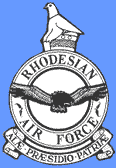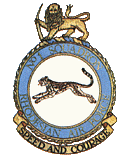No 1 Squadron's Fornation History
It
is now a matter of common knowledge amongst the Force, that No 1
Squadron is by far our oldest unit, having been formed as war
threatened in 1939. Prior to its formation, the aircraft and pilots of
what was then the Territorial Force Air Unit had been called up for
full time service and hurriedly dispatched to Kenya. Their mission was
to provide an Empire air presence in the area to counter the threat
posed by Italian forces in Ethiopia, but it was a somewhat irregular
unit which flew north.
The position was resolved on 19th September 1939, when the Air
Unit officially became the Southern Rhodesia Air Force and the flight
on duty in Kenya became No 1 Squadron, Southern Rhodesia Air Force.
However,
the designation was to last for only seven months, and in April of 1940
the Squadron as a whole was absorbed into the Royal Air Force and
re-numbered No. 237 Squadron.
Since that merger the arguments as to precedence have raged whenever
Rhodesian airmen have gathered. Did No 1Sqadron cease to exist when
swallowed up by 237, or was 237 merely an RAF number for what continued
to be the same Rhodesian unit? Could a squadron which at times
contained many airmen from all over the Empire genuinely claim to be
Rhodesian? And has No 1 Squadron a valid claim to the battle honours
earned by 237 Sqhadron of the Royal Air Force?
The answers to all of these questions may be found in wartime
correspondence which is held at the National Archives and in reports of
wartime discussions held in London. Col. C. W. Meredith the then
Commander of the Southern Rhodesia Air Force returned from an Air
Ministry conference in December 1939 and reported on preliminary
negotiations on the possible absorption of Rhodesian Squadrons.
"It was agreed", he said, "that it would be more convenient and also
avoid confusion if the number of the Rhodesian Squadrons were those of
the Royal Air Force formations and it will therefore be necessary very
shortly, I suggest, to re-number No I Squadron at present in Kenya.
In regard to other Rhodesian Squadrons the decision will naturally be
deferred until it is decided whether we are to take over existing
Squadrons or whether new squadrons are to be formed.
My memory is, that when approximately one third of the
personnel in any squadron is Rhodesian, that the word "Rhodesia" would
be added to the existing designation, e.g. No .... (Rhodesia) Squadron
Royal Air Force, and that at a later stage when the whole of the
personnel were Rhodesian, Air Ministry would be prepared to consider
dropping the words `Royal Air Force' and substituting therefore
`Rhodesian Air Force' but retaining the original Royal Air Force
number."
Thus was the stage set. But before negotiations had progressed
much further a new factor was to simplify the issue and it was this
factor which was finally to decide the Squadron's fate. On the question
of finance the Air Ministry stated that if the Southern Rhodesia Air
Force became an R.A.F. responsibility for all maintenance costs
including pay for all personnel would come from London.
Indeed, the subsequent signal authorising the transaction arranged for
Rhodesians to be paid by the R.A.F. even before they had re-attested
into that service.
In the event a telegram from London informed Salisbury that, "As from
1st April, 1940, No 1 Squadron Southern Rhodesia Air Force was renamed
number 237 (Southern Rhodesia) (Bomber) Squadron, Royal Air Force."
The wording of that message places beyond doubt the matter of No I
Squadron's right to recognition. The Squadron was not "replaced by" or
"absorbed by" No 237 Squadron - it was merely "renamed" and therefore
continued to exist essentially as before under its new title. It is
also pertinent to note that the unit which has always been regarded as
our premier fighter squadron actually saw the majority of its action as
an official bomber squadron.
However, back in 1940, the squadron was soon to be in action, for the
Italians entered the war in June and fighting broke out along the
Abyssinian border. "A" Flight provided air cover during the battle
around the Moyale, whilst "B" and "C" Flights patrolled the Somali
border.
In September, 1940, the squadron rejoined for a move to
Khartoum, and two months later it received Westland Lysander aircraft
to replace the Hardy's with which it had been equipped.
Four months later one Flight was further re-equipped with Gloster
Gladiators, and then in April 1941 the squadron moved to occupy Asmara
after the Italian surrender. Further moves took it to Wadi Haifa in
June and Kasfareet in August and then its attention was turned towards
Libya and the Western Desert.
By November 1941, No. 237 Squadron was equipped with
Hurricanes and was embroiled in the see-saw battles with the Afrika
Korps and the Luftwaffe. In February 1942, it was ordered back to
Ismailia in the Canal Zone before traveling yet farther east. The next
year was spent covering the Iraq/Persia sector with the squadron
operating from such bases as Mosul, Kermanshah and Kirkuk. In March
1943, it returned to the Canal Zone, where it's role was changed from
army co-operation to fighter reconnaissance. A long spell of operations
across North Africa followed, during which the squadron moved
progressively westward.
April 1944, saw No. 237 Squadron equipped with Spitfires and
based first at Serragia and then at Kalvi on Corsica, whilst it
operated against the enemy in Northern Italy and Southern France. With
the war obviously coming to an end, the Squadron was gradually loosing
it's all-Rhodesian nature. It became increasingly difficult to replace
personnel who had completed their operational tour and after two more
moves to France and Italy, the Squadron was eventually disbanded in
1945.
On a historical note the Southern Rhodesia Staff Corps Air
Unit became the Southern Rhodesia Ait Force in 1951 and then the Royal
Rhodesian Air Force after the formation of the Federation. After UDI
the Queen withdrew the entitlement to the Royal prefix and it became
Rhodesian Air Force and in 1980 the Air Force of Zimbabwe. I am sure it
was the only Air Force in the world that had 5 different official
titles in 30 years!
Anon. Extracted from the Bateleur Newsletter


